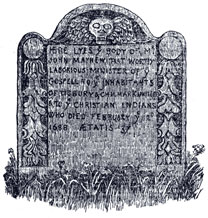Study Guide Death

Table of Contents
Gravestones
 In addition to providing crucial statistical and biographical information, gravestones help us understand the way the living wished to commemorate the deceased and their views of the afterlife. The gravestone of John Mayhew (right), father of Experience Mayhew, is rich in Puritan symbolism. Puritan gravestones, like Puritan histories and literature, were created with an eye towards the moment of resurrection and the apocalypse (Watters 1). At the root of much of Puritan imagery is a firm belief in typology and prophecy (Watters 47-49). Typology allowed Puritans to read both the Hebrew Bible as a prophesy of the New Testament, and both testaments as a prophesy of their own experience in the Americas. In the most specific sense, typology refers to the interpretation of events, persons, and ceremonies from the Hebrew Bible as precursors to Christ and the New Testament. For every Hebrew Bible type (person or event) there was a New Testament anti-type (person or event) that fulfilled the promise the original prophesy. Puritans also, however, read the events and figures of the Bible as types for the events and personages of New England: in this way, Puritan history fulfilled the prophesy of the Old and New Testaments and signaled the eminent return of Christ. When Mayhew’s copious biblical allusions that are woven throughout Indian Converts are one example of this typological vision: for example, when Mayhew uses Job 1.7 to make sense of the Catholic Missionaries in America, he not only believes the Catholics are Satan, but also he uses the type in Job to implicitly argue for the way that his mission fulfills biblical prophecy and marks the Second Coming.
In addition to providing crucial statistical and biographical information, gravestones help us understand the way the living wished to commemorate the deceased and their views of the afterlife. The gravestone of John Mayhew (right), father of Experience Mayhew, is rich in Puritan symbolism. Puritan gravestones, like Puritan histories and literature, were created with an eye towards the moment of resurrection and the apocalypse (Watters 1). At the root of much of Puritan imagery is a firm belief in typology and prophecy (Watters 47-49). Typology allowed Puritans to read both the Hebrew Bible as a prophesy of the New Testament, and both testaments as a prophesy of their own experience in the Americas. In the most specific sense, typology refers to the interpretation of events, persons, and ceremonies from the Hebrew Bible as precursors to Christ and the New Testament. For every Hebrew Bible type (person or event) there was a New Testament anti-type (person or event) that fulfilled the promise the original prophesy. Puritans also, however, read the events and figures of the Bible as types for the events and personages of New England: in this way, Puritan history fulfilled the prophesy of the Old and New Testaments and signaled the eminent return of Christ. When Mayhew’s copious biblical allusions that are woven throughout Indian Converts are one example of this typological vision: for example, when Mayhew uses Job 1.7 to make sense of the Catholic Missionaries in America, he not only believes the Catholics are Satan, but also he uses the type in Job to implicitly argue for the way that his mission fulfills biblical prophecy and marks the Second Coming.
The iconography of Puritan gravestones is similarly typological and prophetic. Stones like that of John Mayhew are framed by pillars that recall the Temple in Jerusalem which will be rebuilt in the messianic era and thus mark the “imminent return of the resurrected saints as pillars of the New Jerusalem Temple” (Watters 53). The stone also contains fig leaves and clusters of breast that “recall various biblical texts extolling the fruitfulness of Christian life” (Watters 108). Puritan ministers used the Song of Solomon (Canticles) to envision ministers as women’s breasts from whom their congregants “may receive the sincere milk of the Word” (Leverenz 143; Watters 108-09). This same motif was reflected in John Cotton’s catechism entitled Spiritual Milk for Babes. This type reflected the Puritan belief that upon conversion, congregants would become like an infant utterly dependent upon God and would “wean their affections” away from worldly affairs (Leverenz 144). Grapes signifying the saving grace of the Sacrament were also common. These “optimistic” signs were balanced by warnings such as death’s heads, father time, hour glasses, and the like. The winged death’s head is the quintessential combination of Puritan hope and despair: it both emphasizes the mortality of the flesh through the skull, and the possible ascent of the spirit through the wings. In the second half of the eighteenth-century a winged cherub, a more consoling and optimistic sign, gradually replaced this ambiguous winged skull. The dedication of the Mayhew family [Mayhew Family Gravestones] to the death’s head image throughout this period of transformation could indicate either their theological conservativism or the delay of trends between the mainland and the Vineyard, particularly given that other late eighteenth-century stones on the island also bear the same emblem.
For more information on Gravestones, see the Reading Gravestones Study Guide.
Items Related to Gravestones in the Archive
Burial Practice < Previous | Next > Funeral Sermons